A Literature Review: Lifecycle Nutrition, Food Analysis, and Needs
VerifiedAdded on 2023/01/03
|9
|2372
|49
Literature Review
AI Summary
This literature review examines lifecycle nutrition, focusing on the analysis of food composition and production methods, and how nutrient requirements change across the human lifespan. The introduction highlights the importance of balanced diets for various life stages, emphasizing the impact of nutrition on physical health and well-being. The main body of the review delves into methods of food analysis, discussing the significance of determining food quality and identifying potential contaminants. It further explores the changing nutritional needs during childhood and adulthood, considering factors such as growth, development, and lifestyle changes. The review emphasizes the importance of balanced diets, adequate intake of macronutrients and micronutrients, and the role of family and environmental factors in shaping eating habits. The conclusion summarizes the key findings, underscoring the importance of understanding lifecycle nutrition for maintaining health and wellness throughout life.
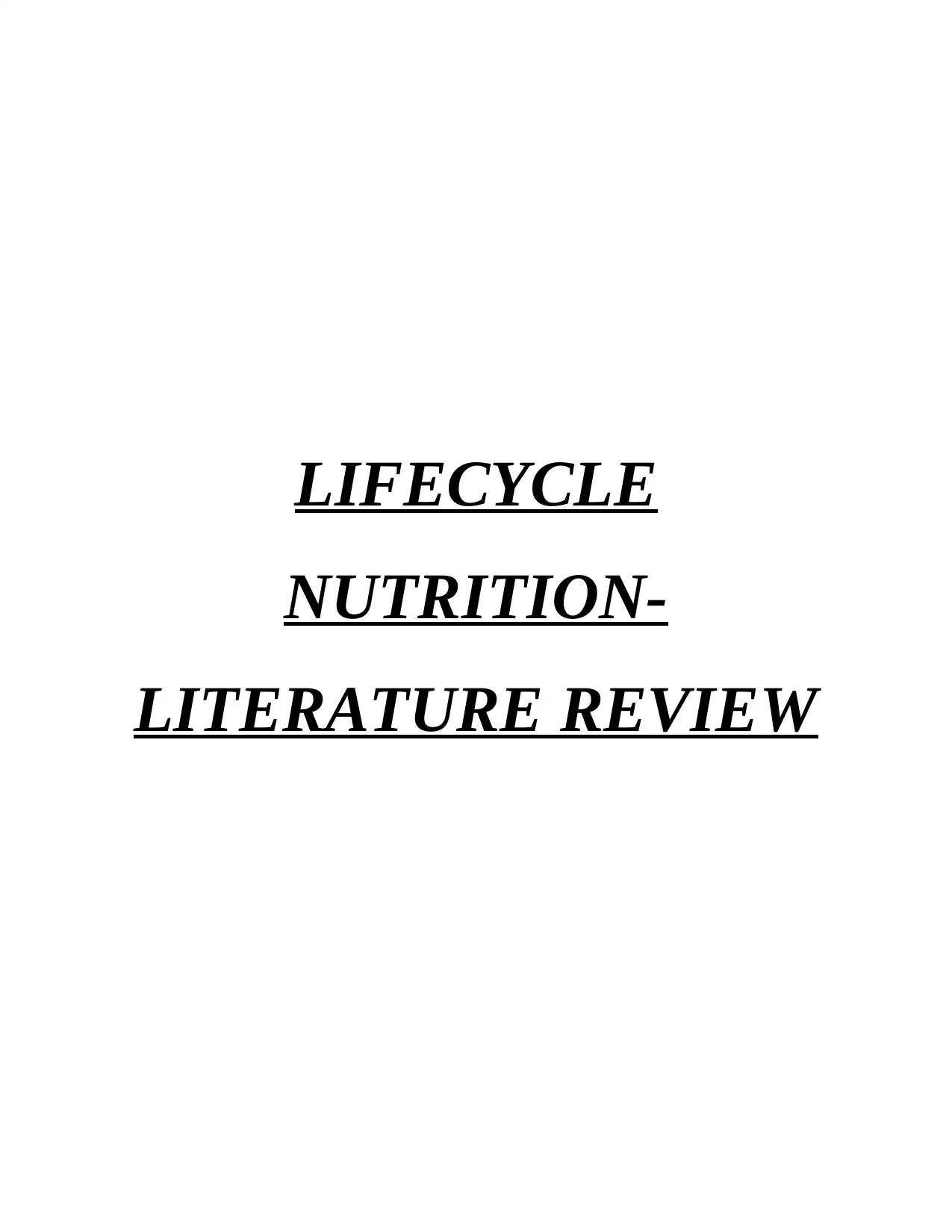
LIFECYCLE
NUTRITION-
LITERATURE REVIEW
NUTRITION-
LITERATURE REVIEW
Paraphrase This Document
Need a fresh take? Get an instant paraphrase of this document with our AI Paraphraser
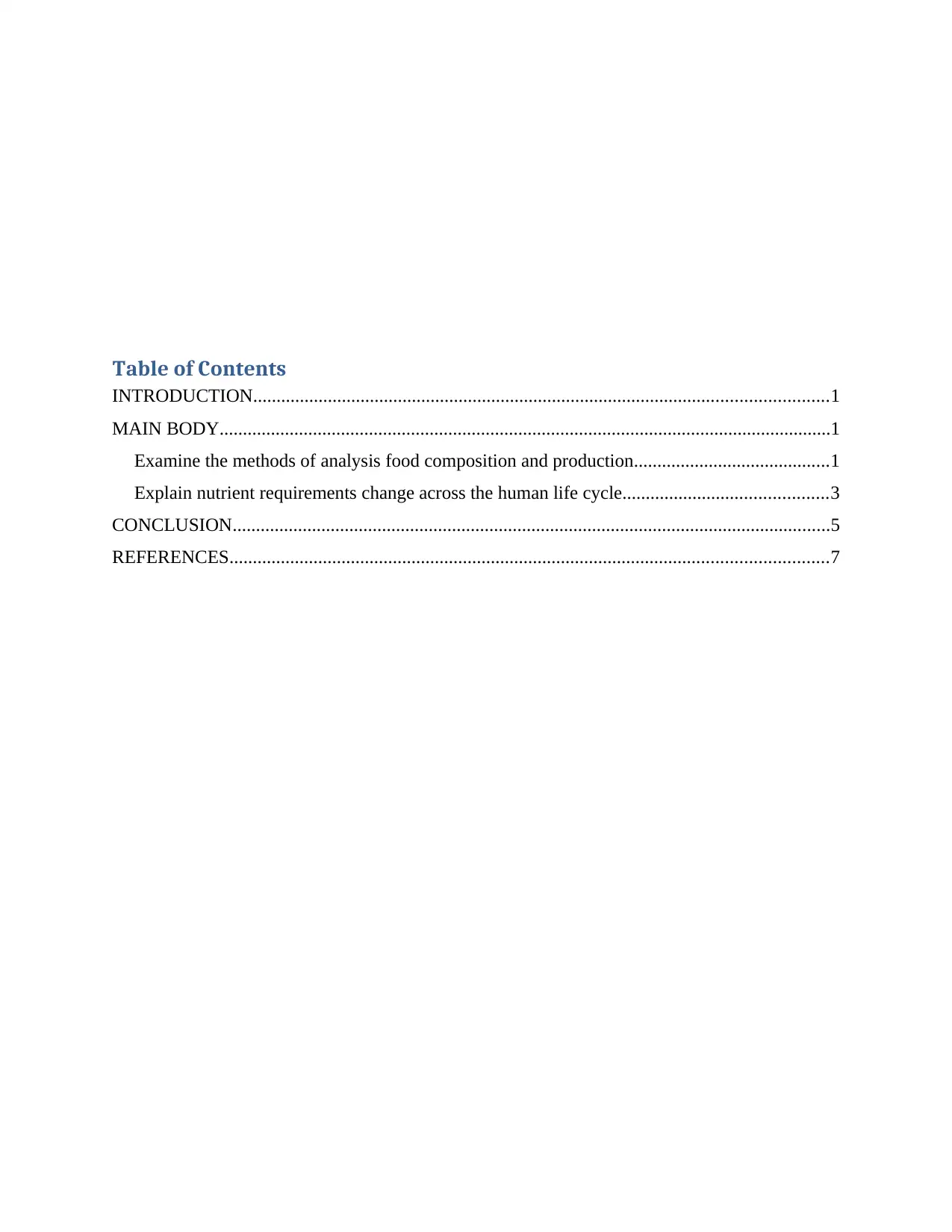
Table of Contents
INTRODUCTION...........................................................................................................................1
MAIN BODY...................................................................................................................................1
Examine the methods of analysis food composition and production..........................................1
Explain nutrient requirements change across the human life cycle............................................3
CONCLUSION................................................................................................................................5
REFERENCES................................................................................................................................7
INTRODUCTION...........................................................................................................................1
MAIN BODY...................................................................................................................................1
Examine the methods of analysis food composition and production..........................................1
Explain nutrient requirements change across the human life cycle............................................3
CONCLUSION................................................................................................................................5
REFERENCES................................................................................................................................7
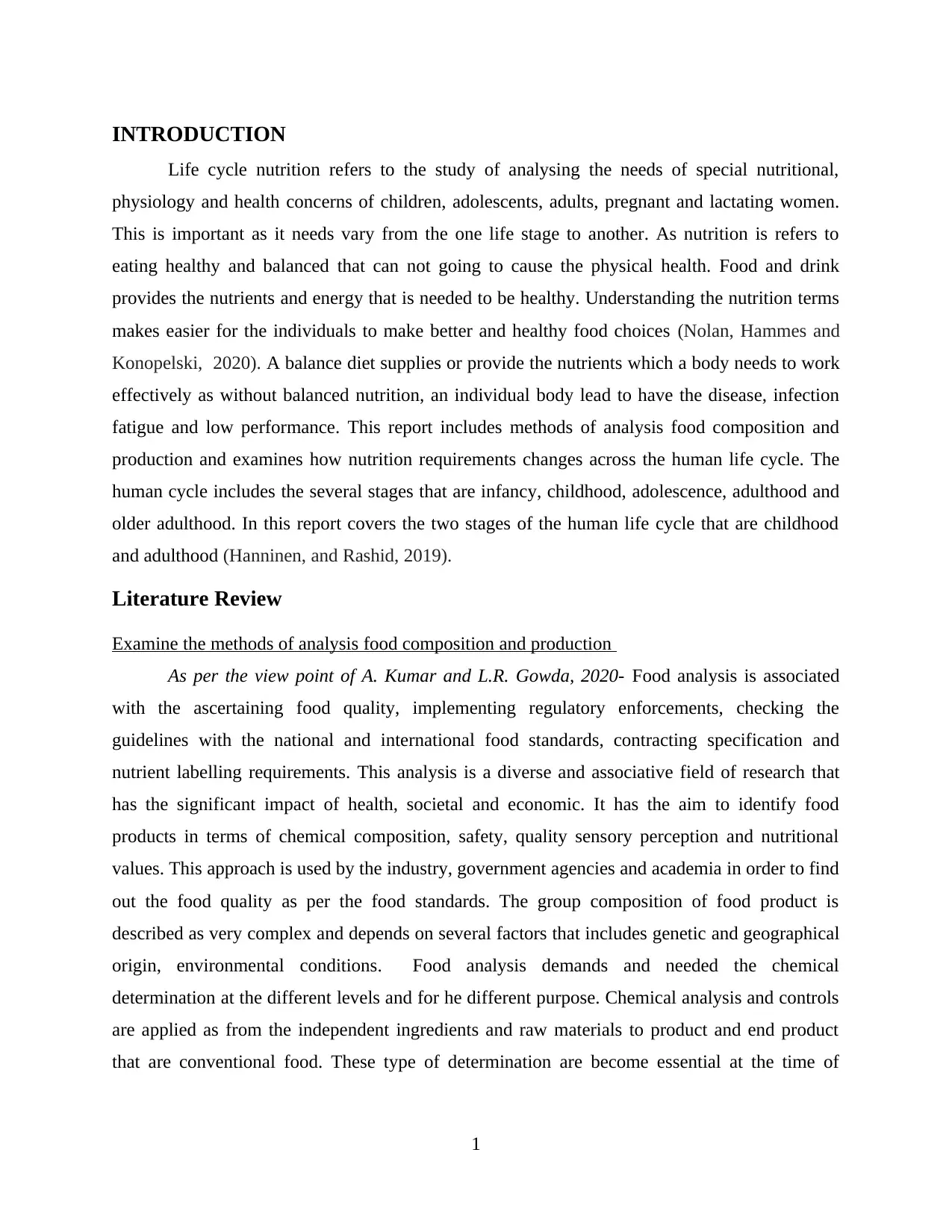
INTRODUCTION
Life cycle nutrition refers to the study of analysing the needs of special nutritional,
physiology and health concerns of children, adolescents, adults, pregnant and lactating women.
This is important as it needs vary from the one life stage to another. As nutrition is refers to
eating healthy and balanced that can not going to cause the physical health. Food and drink
provides the nutrients and energy that is needed to be healthy. Understanding the nutrition terms
makes easier for the individuals to make better and healthy food choices (Nolan, Hammes and
Konopelski, 2020). A balance diet supplies or provide the nutrients which a body needs to work
effectively as without balanced nutrition, an individual body lead to have the disease, infection
fatigue and low performance. This report includes methods of analysis food composition and
production and examines how nutrition requirements changes across the human life cycle. The
human cycle includes the several stages that are infancy, childhood, adolescence, adulthood and
older adulthood. In this report covers the two stages of the human life cycle that are childhood
and adulthood (Hanninen, and Rashid, 2019).
Literature Review
Examine the methods of analysis food composition and production
As per the view point of A. Kumar and L.R. Gowda, 2020- Food analysis is associated
with the ascertaining food quality, implementing regulatory enforcements, checking the
guidelines with the national and international food standards, contracting specification and
nutrient labelling requirements. This analysis is a diverse and associative field of research that
has the significant impact of health, societal and economic. It has the aim to identify food
products in terms of chemical composition, safety, quality sensory perception and nutritional
values. This approach is used by the industry, government agencies and academia in order to find
out the food quality as per the food standards. The group composition of food product is
described as very complex and depends on several factors that includes genetic and geographical
origin, environmental conditions. Food analysis demands and needed the chemical
determination at the different levels and for he different purpose. Chemical analysis and controls
are applied as from the independent ingredients and raw materials to product and end product
that are conventional food. These type of determination are become essential at the time of
1
Life cycle nutrition refers to the study of analysing the needs of special nutritional,
physiology and health concerns of children, adolescents, adults, pregnant and lactating women.
This is important as it needs vary from the one life stage to another. As nutrition is refers to
eating healthy and balanced that can not going to cause the physical health. Food and drink
provides the nutrients and energy that is needed to be healthy. Understanding the nutrition terms
makes easier for the individuals to make better and healthy food choices (Nolan, Hammes and
Konopelski, 2020). A balance diet supplies or provide the nutrients which a body needs to work
effectively as without balanced nutrition, an individual body lead to have the disease, infection
fatigue and low performance. This report includes methods of analysis food composition and
production and examines how nutrition requirements changes across the human life cycle. The
human cycle includes the several stages that are infancy, childhood, adolescence, adulthood and
older adulthood. In this report covers the two stages of the human life cycle that are childhood
and adulthood (Hanninen, and Rashid, 2019).
Literature Review
Examine the methods of analysis food composition and production
As per the view point of A. Kumar and L.R. Gowda, 2020- Food analysis is associated
with the ascertaining food quality, implementing regulatory enforcements, checking the
guidelines with the national and international food standards, contracting specification and
nutrient labelling requirements. This analysis is a diverse and associative field of research that
has the significant impact of health, societal and economic. It has the aim to identify food
products in terms of chemical composition, safety, quality sensory perception and nutritional
values. This approach is used by the industry, government agencies and academia in order to find
out the food quality as per the food standards. The group composition of food product is
described as very complex and depends on several factors that includes genetic and geographical
origin, environmental conditions. Food analysis demands and needed the chemical
determination at the different levels and for he different purpose. Chemical analysis and controls
are applied as from the independent ingredients and raw materials to product and end product
that are conventional food. These type of determination are become essential at the time of
1
You're viewing a preview
Unlock full access by subscribing today!
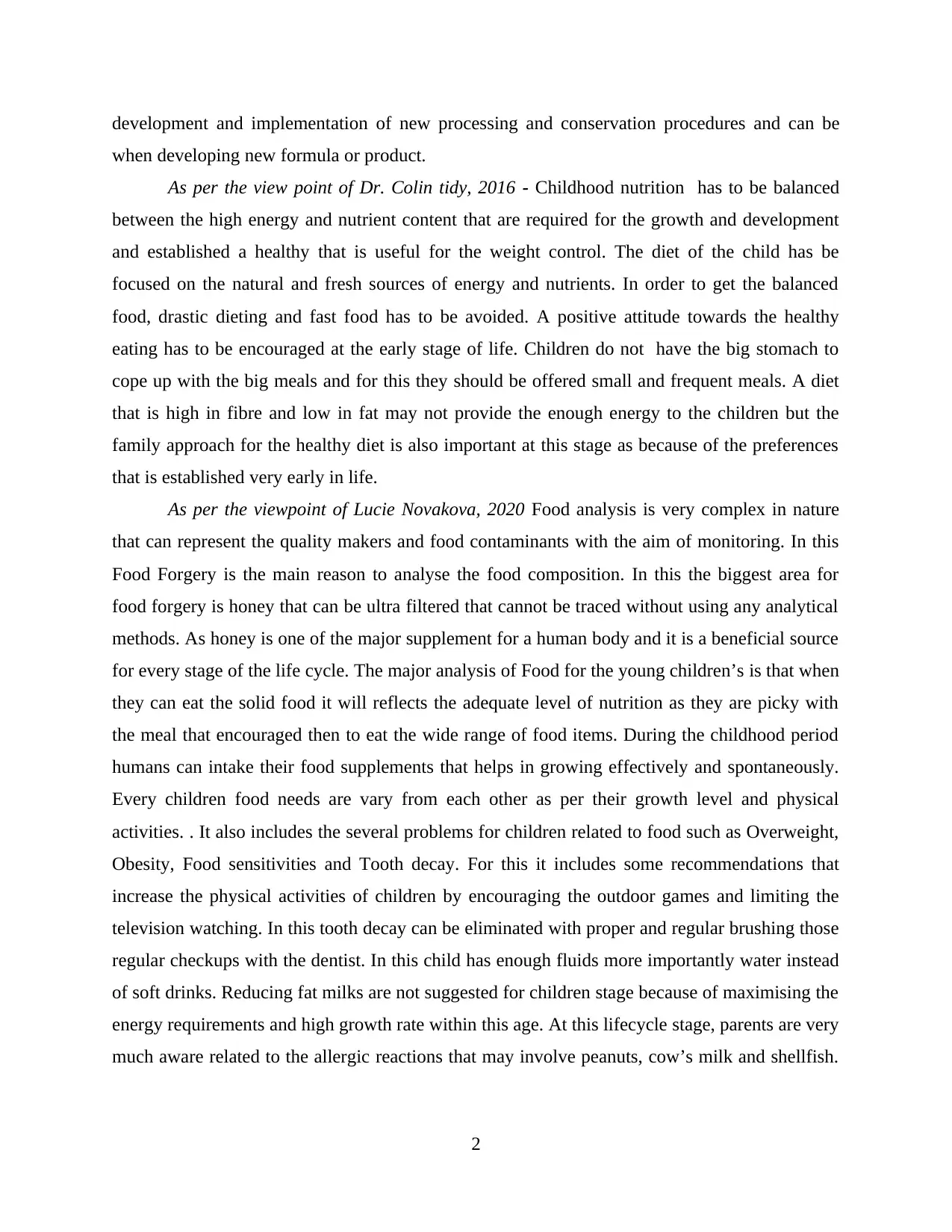
development and implementation of new processing and conservation procedures and can be
when developing new formula or product.
As per the view point of Dr. Colin tidy, 2016 - Childhood nutrition has to be balanced
between the high energy and nutrient content that are required for the growth and development
and established a healthy that is useful for the weight control. The diet of the child has be
focused on the natural and fresh sources of energy and nutrients. In order to get the balanced
food, drastic dieting and fast food has to be avoided. A positive attitude towards the healthy
eating has to be encouraged at the early stage of life. Children do not have the big stomach to
cope up with the big meals and for this they should be offered small and frequent meals. A diet
that is high in fibre and low in fat may not provide the enough energy to the children but the
family approach for the healthy diet is also important at this stage as because of the preferences
that is established very early in life.
As per the viewpoint of Lucie Novakova, 2020 Food analysis is very complex in nature
that can represent the quality makers and food contaminants with the aim of monitoring. In this
Food Forgery is the main reason to analyse the food composition. In this the biggest area for
food forgery is honey that can be ultra filtered that cannot be traced without using any analytical
methods. As honey is one of the major supplement for a human body and it is a beneficial source
for every stage of the life cycle. The major analysis of Food for the young children’s is that when
they can eat the solid food it will reflects the adequate level of nutrition as they are picky with
the meal that encouraged then to eat the wide range of food items. During the childhood period
humans can intake their food supplements that helps in growing effectively and spontaneously.
Every children food needs are vary from each other as per their growth level and physical
activities. . It also includes the several problems for children related to food such as Overweight,
Obesity, Food sensitivities and Tooth decay. For this it includes some recommendations that
increase the physical activities of children by encouraging the outdoor games and limiting the
television watching. In this tooth decay can be eliminated with proper and regular brushing those
regular checkups with the dentist. In this child has enough fluids more importantly water instead
of soft drinks. Reducing fat milks are not suggested for children stage because of maximising the
energy requirements and high growth rate within this age. At this lifecycle stage, parents are very
much aware related to the allergic reactions that may involve peanuts, cow’s milk and shellfish.
2
when developing new formula or product.
As per the view point of Dr. Colin tidy, 2016 - Childhood nutrition has to be balanced
between the high energy and nutrient content that are required for the growth and development
and established a healthy that is useful for the weight control. The diet of the child has be
focused on the natural and fresh sources of energy and nutrients. In order to get the balanced
food, drastic dieting and fast food has to be avoided. A positive attitude towards the healthy
eating has to be encouraged at the early stage of life. Children do not have the big stomach to
cope up with the big meals and for this they should be offered small and frequent meals. A diet
that is high in fibre and low in fat may not provide the enough energy to the children but the
family approach for the healthy diet is also important at this stage as because of the preferences
that is established very early in life.
As per the viewpoint of Lucie Novakova, 2020 Food analysis is very complex in nature
that can represent the quality makers and food contaminants with the aim of monitoring. In this
Food Forgery is the main reason to analyse the food composition. In this the biggest area for
food forgery is honey that can be ultra filtered that cannot be traced without using any analytical
methods. As honey is one of the major supplement for a human body and it is a beneficial source
for every stage of the life cycle. The major analysis of Food for the young children’s is that when
they can eat the solid food it will reflects the adequate level of nutrition as they are picky with
the meal that encouraged then to eat the wide range of food items. During the childhood period
humans can intake their food supplements that helps in growing effectively and spontaneously.
Every children food needs are vary from each other as per their growth level and physical
activities. . It also includes the several problems for children related to food such as Overweight,
Obesity, Food sensitivities and Tooth decay. For this it includes some recommendations that
increase the physical activities of children by encouraging the outdoor games and limiting the
television watching. In this tooth decay can be eliminated with proper and regular brushing those
regular checkups with the dentist. In this child has enough fluids more importantly water instead
of soft drinks. Reducing fat milks are not suggested for children stage because of maximising the
energy requirements and high growth rate within this age. At this lifecycle stage, parents are very
much aware related to the allergic reactions that may involve peanuts, cow’s milk and shellfish.
2
Paraphrase This Document
Need a fresh take? Get an instant paraphrase of this document with our AI Paraphraser
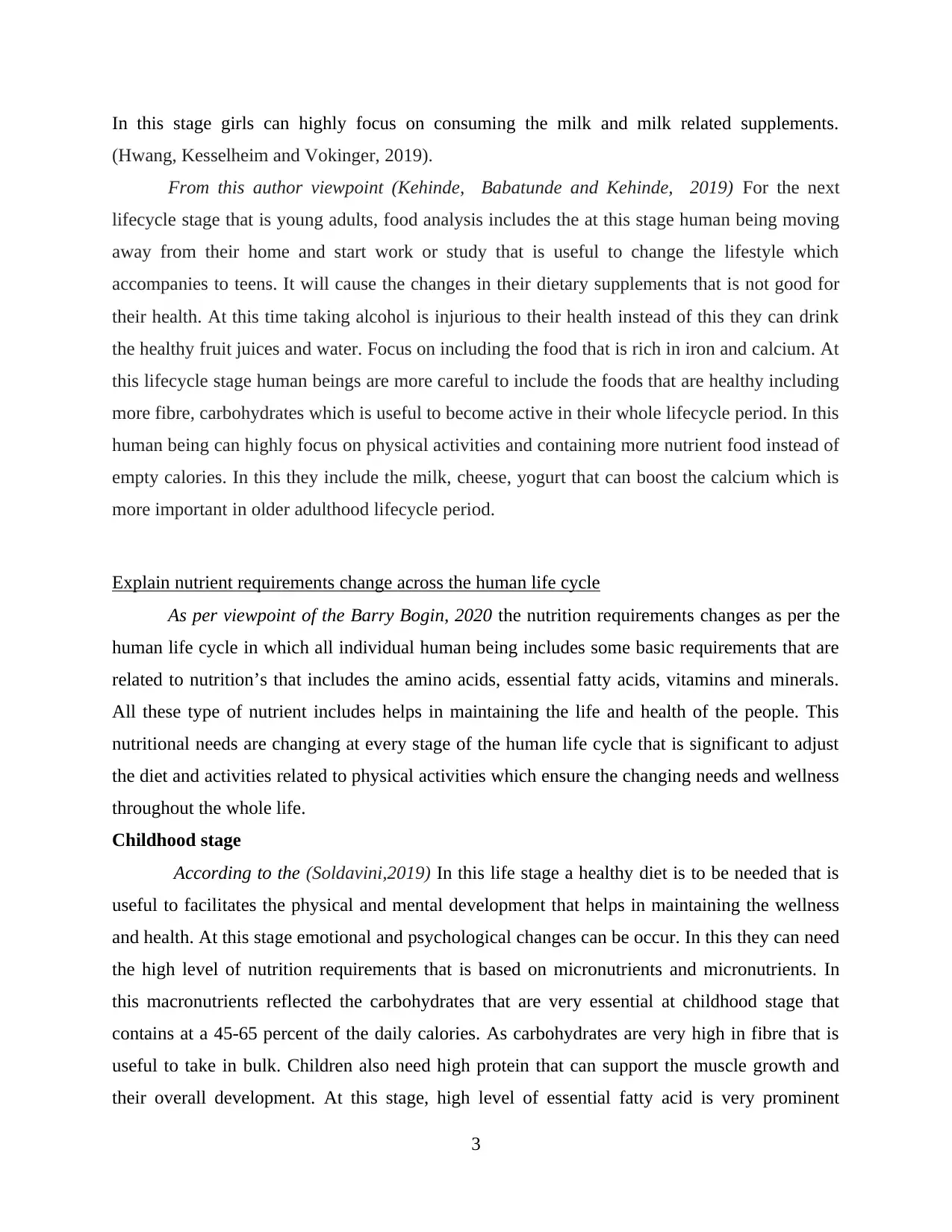
In this stage girls can highly focus on consuming the milk and milk related supplements.
(Hwang, Kesselheim and Vokinger, 2019).
From this author viewpoint (Kehinde, Babatunde and Kehinde, 2019) For the next
lifecycle stage that is young adults, food analysis includes the at this stage human being moving
away from their home and start work or study that is useful to change the lifestyle which
accompanies to teens. It will cause the changes in their dietary supplements that is not good for
their health. At this time taking alcohol is injurious to their health instead of this they can drink
the healthy fruit juices and water. Focus on including the food that is rich in iron and calcium. At
this lifecycle stage human beings are more careful to include the foods that are healthy including
more fibre, carbohydrates which is useful to become active in their whole lifecycle period. In this
human being can highly focus on physical activities and containing more nutrient food instead of
empty calories. In this they include the milk, cheese, yogurt that can boost the calcium which is
more important in older adulthood lifecycle period.
Explain nutrient requirements change across the human life cycle
As per viewpoint of the Barry Bogin, 2020 the nutrition requirements changes as per the
human life cycle in which all individual human being includes some basic requirements that are
related to nutrition’s that includes the amino acids, essential fatty acids, vitamins and minerals.
All these type of nutrient includes helps in maintaining the life and health of the people. This
nutritional needs are changing at every stage of the human life cycle that is significant to adjust
the diet and activities related to physical activities which ensure the changing needs and wellness
throughout the whole life.
Childhood stage
According to the (Soldavini,2019) In this life stage a healthy diet is to be needed that is
useful to facilitates the physical and mental development that helps in maintaining the wellness
and health. At this stage emotional and psychological changes can be occur. In this they can need
the high level of nutrition requirements that is based on micronutrients and micronutrients. In
this macronutrients reflected the carbohydrates that are very essential at childhood stage that
contains at a 45-65 percent of the daily calories. As carbohydrates are very high in fibre that is
useful to take in bulk. Children also need high protein that can support the muscle growth and
their overall development. At this stage, high level of essential fatty acid is very prominent
3
(Hwang, Kesselheim and Vokinger, 2019).
From this author viewpoint (Kehinde, Babatunde and Kehinde, 2019) For the next
lifecycle stage that is young adults, food analysis includes the at this stage human being moving
away from their home and start work or study that is useful to change the lifestyle which
accompanies to teens. It will cause the changes in their dietary supplements that is not good for
their health. At this time taking alcohol is injurious to their health instead of this they can drink
the healthy fruit juices and water. Focus on including the food that is rich in iron and calcium. At
this lifecycle stage human beings are more careful to include the foods that are healthy including
more fibre, carbohydrates which is useful to become active in their whole lifecycle period. In this
human being can highly focus on physical activities and containing more nutrient food instead of
empty calories. In this they include the milk, cheese, yogurt that can boost the calcium which is
more important in older adulthood lifecycle period.
Explain nutrient requirements change across the human life cycle
As per viewpoint of the Barry Bogin, 2020 the nutrition requirements changes as per the
human life cycle in which all individual human being includes some basic requirements that are
related to nutrition’s that includes the amino acids, essential fatty acids, vitamins and minerals.
All these type of nutrient includes helps in maintaining the life and health of the people. This
nutritional needs are changing at every stage of the human life cycle that is significant to adjust
the diet and activities related to physical activities which ensure the changing needs and wellness
throughout the whole life.
Childhood stage
According to the (Soldavini,2019) In this life stage a healthy diet is to be needed that is
useful to facilitates the physical and mental development that helps in maintaining the wellness
and health. At this stage emotional and psychological changes can be occur. In this they can need
the high level of nutrition requirements that is based on micronutrients and micronutrients. In
this macronutrients reflected the carbohydrates that are very essential at childhood stage that
contains at a 45-65 percent of the daily calories. As carbohydrates are very high in fibre that is
useful to take in bulk. Children also need high protein that can support the muscle growth and
their overall development. At this stage, high level of essential fatty acid is very prominent
3
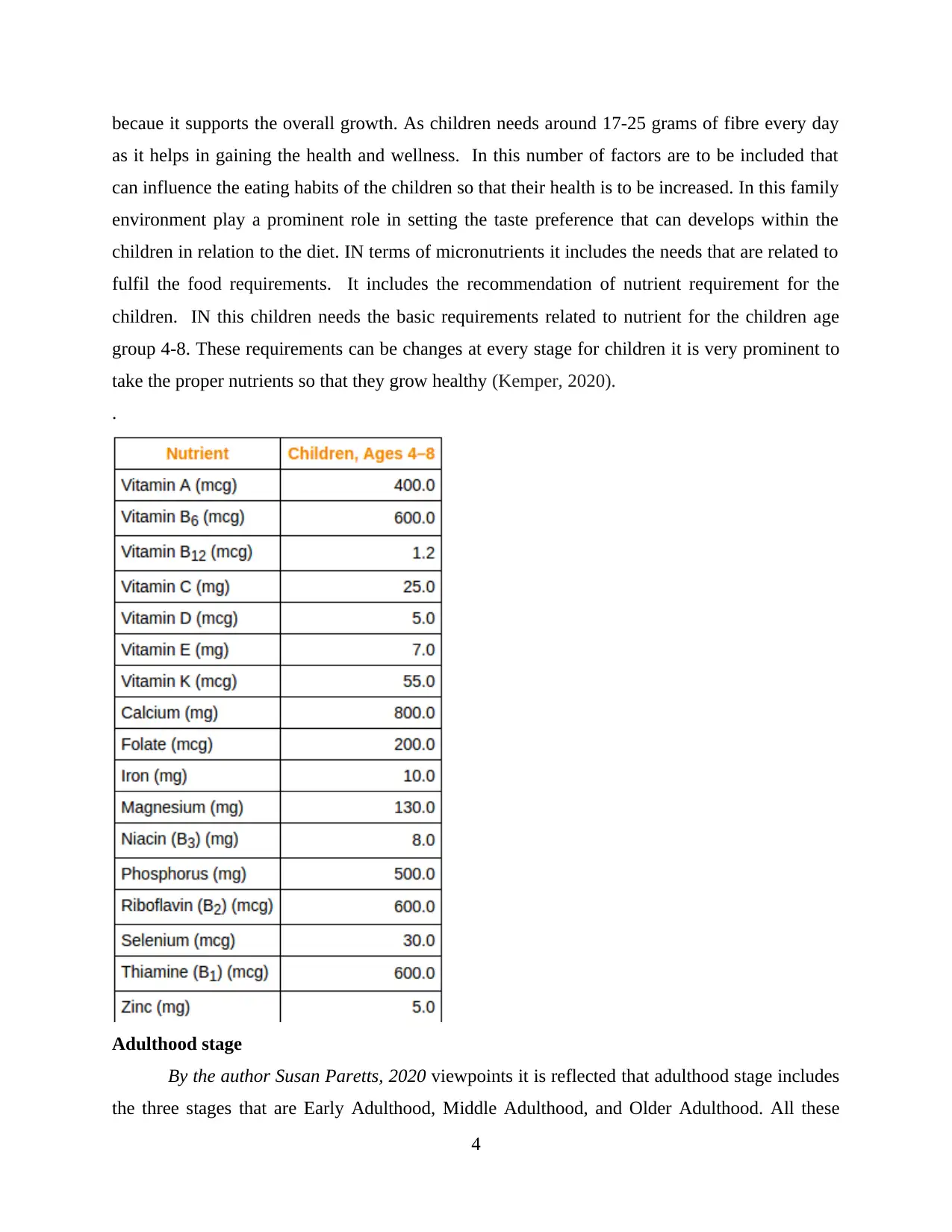
becaue it supports the overall growth. As children needs around 17-25 grams of fibre every day
as it helps in gaining the health and wellness. In this number of factors are to be included that
can influence the eating habits of the children so that their health is to be increased. In this family
environment play a prominent role in setting the taste preference that can develops within the
children in relation to the diet. IN terms of micronutrients it includes the needs that are related to
fulfil the food requirements. It includes the recommendation of nutrient requirement for the
children. IN this children needs the basic requirements related to nutrient for the children age
group 4-8. These requirements can be changes at every stage for children it is very prominent to
take the proper nutrients so that they grow healthy (Kemper, 2020).
.
Adulthood stage
By the author Susan Paretts, 2020 viewpoints it is reflected that adulthood stage includes
the three stages that are Early Adulthood, Middle Adulthood, and Older Adulthood. All these
4
as it helps in gaining the health and wellness. In this number of factors are to be included that
can influence the eating habits of the children so that their health is to be increased. In this family
environment play a prominent role in setting the taste preference that can develops within the
children in relation to the diet. IN terms of micronutrients it includes the needs that are related to
fulfil the food requirements. It includes the recommendation of nutrient requirement for the
children. IN this children needs the basic requirements related to nutrient for the children age
group 4-8. These requirements can be changes at every stage for children it is very prominent to
take the proper nutrients so that they grow healthy (Kemper, 2020).
.
Adulthood stage
By the author Susan Paretts, 2020 viewpoints it is reflected that adulthood stage includes
the three stages that are Early Adulthood, Middle Adulthood, and Older Adulthood. All these
4
You're viewing a preview
Unlock full access by subscribing today!
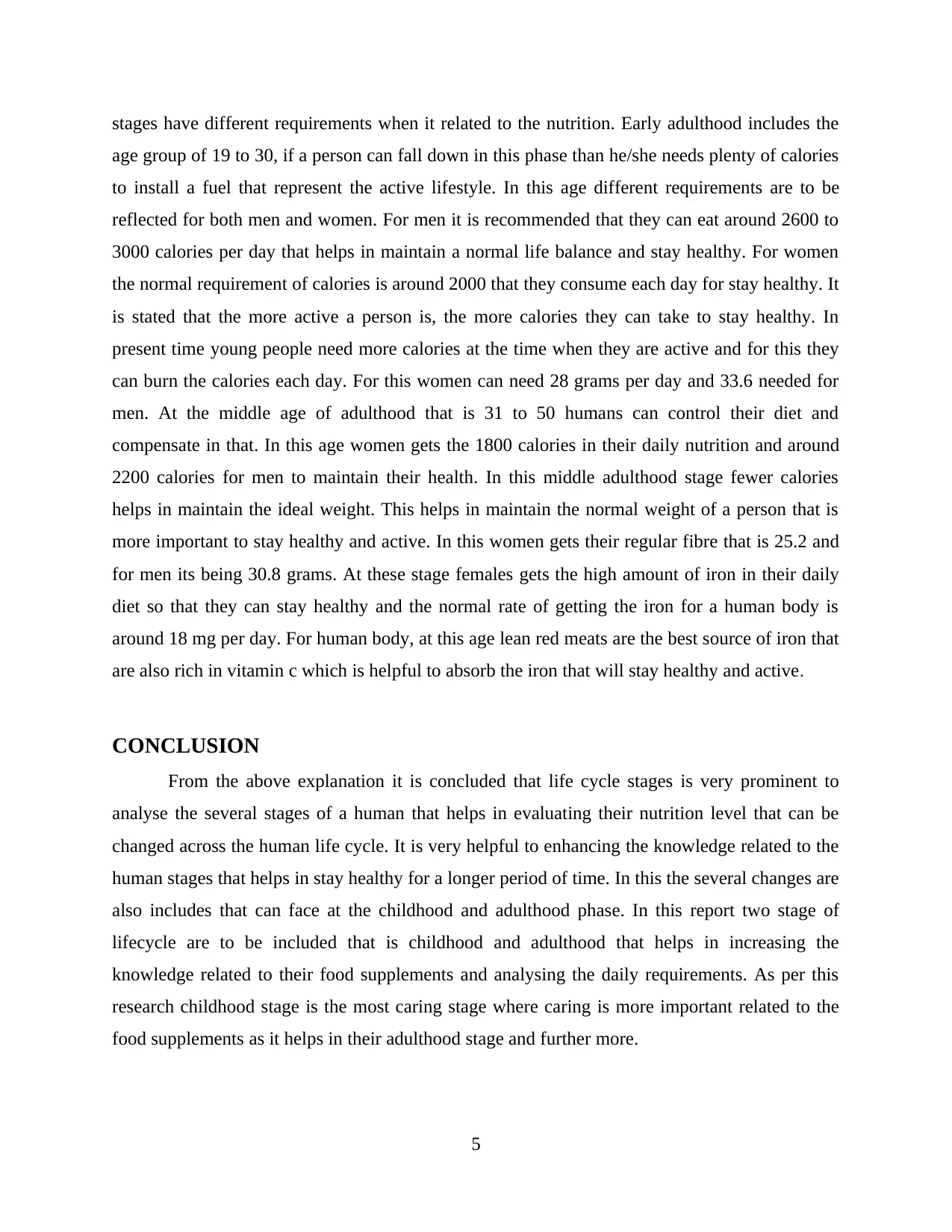
stages have different requirements when it related to the nutrition. Early adulthood includes the
age group of 19 to 30, if a person can fall down in this phase than he/she needs plenty of calories
to install a fuel that represent the active lifestyle. In this age different requirements are to be
reflected for both men and women. For men it is recommended that they can eat around 2600 to
3000 calories per day that helps in maintain a normal life balance and stay healthy. For women
the normal requirement of calories is around 2000 that they consume each day for stay healthy. It
is stated that the more active a person is, the more calories they can take to stay healthy. In
present time young people need more calories at the time when they are active and for this they
can burn the calories each day. For this women can need 28 grams per day and 33.6 needed for
men. At the middle age of adulthood that is 31 to 50 humans can control their diet and
compensate in that. In this age women gets the 1800 calories in their daily nutrition and around
2200 calories for men to maintain their health. In this middle adulthood stage fewer calories
helps in maintain the ideal weight. This helps in maintain the normal weight of a person that is
more important to stay healthy and active. In this women gets their regular fibre that is 25.2 and
for men its being 30.8 grams. At these stage females gets the high amount of iron in their daily
diet so that they can stay healthy and the normal rate of getting the iron for a human body is
around 18 mg per day. For human body, at this age lean red meats are the best source of iron that
are also rich in vitamin c which is helpful to absorb the iron that will stay healthy and active.
CONCLUSION
From the above explanation it is concluded that life cycle stages is very prominent to
analyse the several stages of a human that helps in evaluating their nutrition level that can be
changed across the human life cycle. It is very helpful to enhancing the knowledge related to the
human stages that helps in stay healthy for a longer period of time. In this the several changes are
also includes that can face at the childhood and adulthood phase. In this report two stage of
lifecycle are to be included that is childhood and adulthood that helps in increasing the
knowledge related to their food supplements and analysing the daily requirements. As per this
research childhood stage is the most caring stage where caring is more important related to the
food supplements as it helps in their adulthood stage and further more.
5
age group of 19 to 30, if a person can fall down in this phase than he/she needs plenty of calories
to install a fuel that represent the active lifestyle. In this age different requirements are to be
reflected for both men and women. For men it is recommended that they can eat around 2600 to
3000 calories per day that helps in maintain a normal life balance and stay healthy. For women
the normal requirement of calories is around 2000 that they consume each day for stay healthy. It
is stated that the more active a person is, the more calories they can take to stay healthy. In
present time young people need more calories at the time when they are active and for this they
can burn the calories each day. For this women can need 28 grams per day and 33.6 needed for
men. At the middle age of adulthood that is 31 to 50 humans can control their diet and
compensate in that. In this age women gets the 1800 calories in their daily nutrition and around
2200 calories for men to maintain their health. In this middle adulthood stage fewer calories
helps in maintain the ideal weight. This helps in maintain the normal weight of a person that is
more important to stay healthy and active. In this women gets their regular fibre that is 25.2 and
for men its being 30.8 grams. At these stage females gets the high amount of iron in their daily
diet so that they can stay healthy and the normal rate of getting the iron for a human body is
around 18 mg per day. For human body, at this age lean red meats are the best source of iron that
are also rich in vitamin c which is helpful to absorb the iron that will stay healthy and active.
CONCLUSION
From the above explanation it is concluded that life cycle stages is very prominent to
analyse the several stages of a human that helps in evaluating their nutrition level that can be
changed across the human life cycle. It is very helpful to enhancing the knowledge related to the
human stages that helps in stay healthy for a longer period of time. In this the several changes are
also includes that can face at the childhood and adulthood phase. In this report two stage of
lifecycle are to be included that is childhood and adulthood that helps in increasing the
knowledge related to their food supplements and analysing the daily requirements. As per this
research childhood stage is the most caring stage where caring is more important related to the
food supplements as it helps in their adulthood stage and further more.
5
Paraphrase This Document
Need a fresh take? Get an instant paraphrase of this document with our AI Paraphraser

6
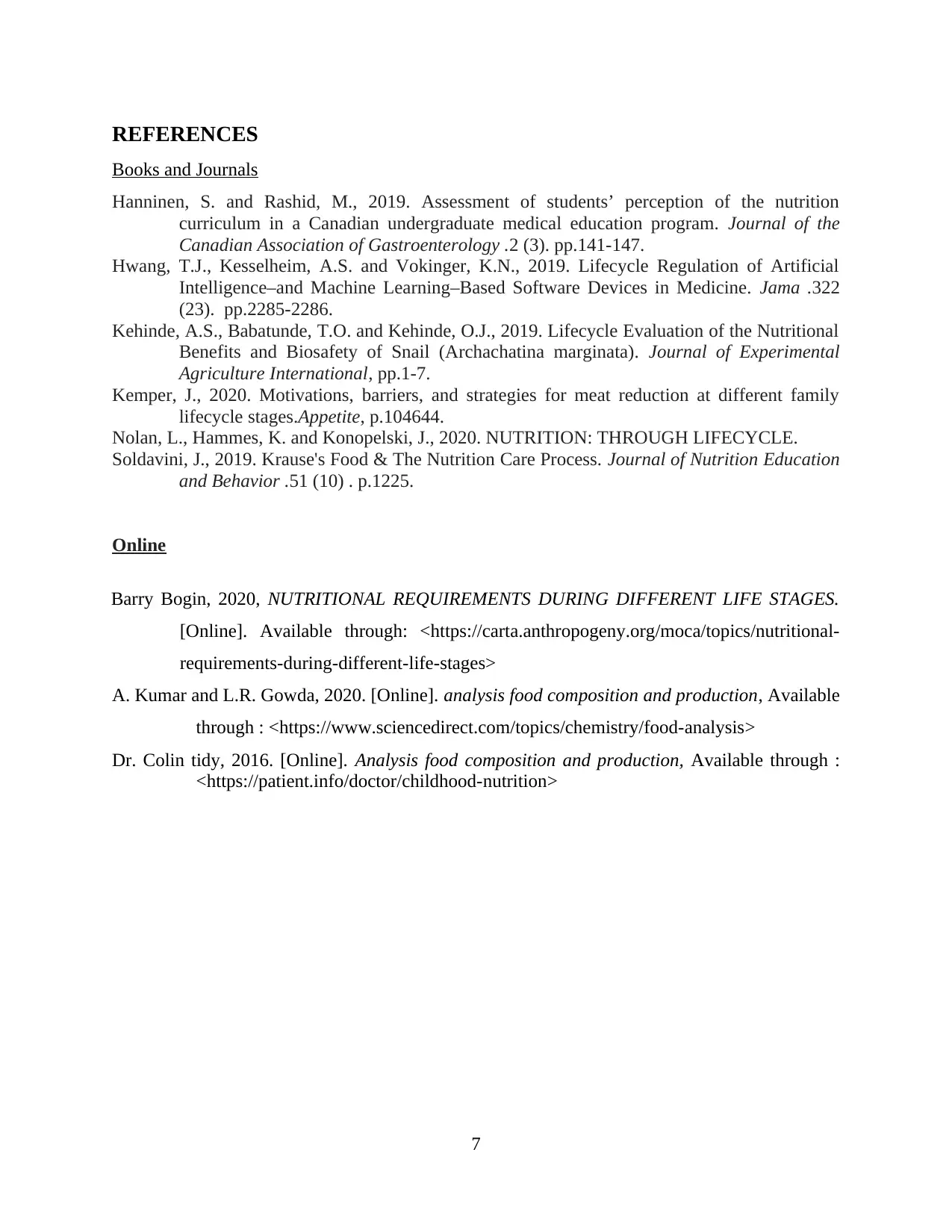
REFERENCES
Books and Journals
Hanninen, S. and Rashid, M., 2019. Assessment of students’ perception of the nutrition
curriculum in a Canadian undergraduate medical education program. Journal of the
Canadian Association of Gastroenterology .2 (3). pp.141-147.
Hwang, T.J., Kesselheim, A.S. and Vokinger, K.N., 2019. Lifecycle Regulation of Artificial
Intelligence–and Machine Learning–Based Software Devices in Medicine. Jama .322
(23). pp.2285-2286.
Kehinde, A.S., Babatunde, T.O. and Kehinde, O.J., 2019. Lifecycle Evaluation of the Nutritional
Benefits and Biosafety of Snail (Archachatina marginata). Journal of Experimental
Agriculture International, pp.1-7.
Kemper, J., 2020. Motivations, barriers, and strategies for meat reduction at different family
lifecycle stages.Appetite, p.104644.
Nolan, L., Hammes, K. and Konopelski, J., 2020. NUTRITION: THROUGH LIFECYCLE.
Soldavini, J., 2019. Krause's Food & The Nutrition Care Process. Journal of Nutrition Education
and Behavior .51 (10) . p.1225.
Online
Barry Bogin, 2020, NUTRITIONAL REQUIREMENTS DURING DIFFERENT LIFE STAGES.
[Online]. Available through: <https://carta.anthropogeny.org/moca/topics/nutritional-
requirements-during-different-life-stages>
A. Kumar and L.R. Gowda, 2020. [Online]. analysis food composition and production, Available
through : <https://www.sciencedirect.com/topics/chemistry/food-analysis>
Dr. Colin tidy, 2016. [Online]. Analysis food composition and production, Available through :
<https://patient.info/doctor/childhood-nutrition>
7
Books and Journals
Hanninen, S. and Rashid, M., 2019. Assessment of students’ perception of the nutrition
curriculum in a Canadian undergraduate medical education program. Journal of the
Canadian Association of Gastroenterology .2 (3). pp.141-147.
Hwang, T.J., Kesselheim, A.S. and Vokinger, K.N., 2019. Lifecycle Regulation of Artificial
Intelligence–and Machine Learning–Based Software Devices in Medicine. Jama .322
(23). pp.2285-2286.
Kehinde, A.S., Babatunde, T.O. and Kehinde, O.J., 2019. Lifecycle Evaluation of the Nutritional
Benefits and Biosafety of Snail (Archachatina marginata). Journal of Experimental
Agriculture International, pp.1-7.
Kemper, J., 2020. Motivations, barriers, and strategies for meat reduction at different family
lifecycle stages.Appetite, p.104644.
Nolan, L., Hammes, K. and Konopelski, J., 2020. NUTRITION: THROUGH LIFECYCLE.
Soldavini, J., 2019. Krause's Food & The Nutrition Care Process. Journal of Nutrition Education
and Behavior .51 (10) . p.1225.
Online
Barry Bogin, 2020, NUTRITIONAL REQUIREMENTS DURING DIFFERENT LIFE STAGES.
[Online]. Available through: <https://carta.anthropogeny.org/moca/topics/nutritional-
requirements-during-different-life-stages>
A. Kumar and L.R. Gowda, 2020. [Online]. analysis food composition and production, Available
through : <https://www.sciencedirect.com/topics/chemistry/food-analysis>
Dr. Colin tidy, 2016. [Online]. Analysis food composition and production, Available through :
<https://patient.info/doctor/childhood-nutrition>
7
You're viewing a preview
Unlock full access by subscribing today!
1 out of 9
Related Documents
Your All-in-One AI-Powered Toolkit for Academic Success.
+13062052269
info@desklib.com
Available 24*7 on WhatsApp / Email
![[object Object]](/_next/static/media/star-bottom.7253800d.svg)
Unlock your academic potential
© 2024 | Zucol Services PVT LTD | All rights reserved.





